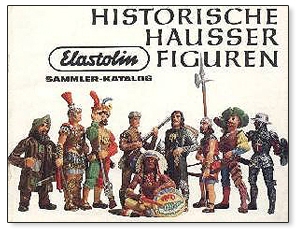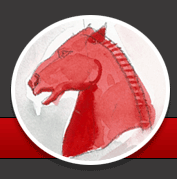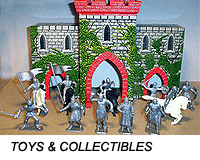
Introduction | Hausser | Elastolin | Preiser | Catalog | wikipedia.org - Elastolin |
Introduction
This page should give you a short overview of the 'Hausser' Elastolin plastic figures. You will find scanned pages of the 'Hausser' Catalog released in 1980. You will find some information about the again released Elastolin figures by 'Preiser'. This page doesn't cover Elastolin "Masse" toys.
Polystyrol-plastic figures in 7 or 4 cm size have been produced
by the company 'Hausser' in Germany for more then 25 years. They became
bankrupt in 29. june 1983. Fortunately the whole equipement necessary
for producing these fine figures was bought by Mr. Preiser (a toy manufacturer
from Germany) and most of the figures are now again available.
Top
Hausser
The company 'Hausser' was founded in 1904 near Stuttgart in Germany by
the brothers Otto and Max Hausser. From the beginning they produced small
figures out of sawdust and glue and wire. This material was called "Masse"
(which means translated 'substance'). First in 10-14 cm size, after 1912
they started also with the famous 7 cm sized toy figures. The company Pfeiffer in Vienna,
brandname Tipple Topple and Durolin, was taken over by Hausser in 1925. In the mid 1930th
the factory was transferred to Neustadt near Coburg. Most off the produced
stuff was war toys. Toy soldiers out of 'Masse' (sawdust and glue) and
excellent cars and cannons in metal has been produced by 'Hausser' in
excellent quality. The company continued toy production up until 1943 during
World War II. After the defeat of Germany, the production started again
around 1946/7.
Mr. Rolf Hausser, the technical manager, started in 1939 against the
opposition of the head office, to develop a way to produce toy figures in
plastic. In 1955 the first 'Wild West' figures were introduced, soon the
'Karl May' and 'Prince Eisenherz' series followed. This first series are
also called the 'J' Series. Then the catalog of 1967 offered the last 'Masse'
figures. In addition to their war toys and castles, the company produced a
lot of civilian toys (animals, farmers).
Top
Elastolin
The brand 'Elastolin' was used by 'Hausser' since the beginning. Because
there was no possibility to protect this brandname, Elastolin is now accepted
as a generic term for almost any composition figure.
A porridge-like mixture of sawdust, cassein glue and kaolin has been
pressed in a brass mold and a wire strengthener has been applied.
These halves has then been joined, pre dried and heated. Afterwards
these figures have then been hand painted. These technique is also used for
'Lineol' figures, which are compatible to Elastolin figures. 'Lineol' has
nothing to do with 'Hauser' or 'Elastolin'.
After introduction of the plastic figures in 1955 the name 'Elastolin'
has also been used for these types. If you ask for elastolin its a good idea
to check weather you talk about composition or plastic models. From here on we
are talking only about plastic figures!
There is a wide range of variations in style and painting. The older
types ('J' series) was sprayed in a brass mold, which wear out very
fast. The figures then have been new designed and sprayed in steel mold.
There are three main painting variations.
Characteristic for 'Hausser' figures is the oval socket, which has been used before World War I. The first used socket on plastics was the dark green
'J' type with a high dot and a printed 'J' underneath. The next used sockets
didn't have the printed 'J' and varied in color. If you wonder, how to distinguish
between the high priced, antic 'Hausser' figures and the cheaper 'Preiser'
manufactured figures, there is an easy hint. As you see on this picture the 'Preiser' socket don't have a protruding dot.
Top
Preiser
The company 'Preiser' is well know for high quality toy figures and model railroad accessories. They also produce the 'Elastolin' figures after Mr. Preiser bought the whole equipment at the auction of the bankrupt 'Hausser' company. Because they use different numbers I made a list which compares the 'Hauser' and the 'Preiser' ordering numbers.
Preiser
Top
|
Catalog
The catalog numbers has the following meanings:
8401 = 7cm M1 : 25
8401 4 = 4cm M1 : 45
Click on a Catalog Page number to view, then use your "Back Button" to return".
|
Page
01 Frontpage
02 Introduction (Vorwort)
03 Roman legionnaires (Roemer,
Legionnaire)
04 Roman legionnaires (Roemer,
Legionnaire)
05 Roman legionnaires (Roemer,
Legionnaire)
06 Vikings (Wikinger)
07 Bow shooter (Bogenschuetze)
08 Huns (Hunnen)
09 Huns (Hunnen)
10 Normans (Normannen)
11 Normans (Normannen)
12 Normans (Normannen)
13 Normans (Normannen)
14 Knights (Ritter)
15 Billingsgate
16 Billingsgate
17 Billingsgate
18 Billingsgate
19 Turks (Tuerken)
20 Castle occupants (Burggesinde)
21 Cannons (Mittelalterliche Geschuetze)
22 Cannons (Mittelalterliche Geschuetze)
23 Cannons (Mittelalterliche Geschuetze)
24 Cannons (Mittelalterliche Geschuetze)
25 Cannons (Mittelalterliche Geschuetze)
26 Native Americans (Indianer)
27 Native Americans (Indianer)
28 Native Americans (Indianer)
29 Native Americans (Indianer)
30 Native Americans (Indianer)
|
Page
31 Trapper
32 Trapper
33 Trapper
34 Trapper
35 Trapper
36 US soldier (Regierungstruppen)
37 Karl May figures
38 Karl May figures
39 Karl May figures
40 Settler (Siedler)
41 Infanterieregiment 'Washington'
42 Infanterieregiment 'Washington'
43 Infanterieregiment 'Specht'
44 Infanterieregiment 'Specht'
45 Britische Grenadiere
46 Britische Grenadiere
47 American Militia
48 American Militia
49 Preussische Infanteristen
50 Preussische Infanteristen
51 US civil war 'North' (Nordstaaten)
52 US civil war 'South' (Suedstaaten)
53 Austrian army (Oesterreichisches
Bundesheer)
54 Swiss army (Schweizer Bundesheer)
55 German army 1939 (Deutsche
Wehrmacht 1939)
56 German army 1939 (Deutsche
Wehrmacht 1939)
57 German army 1939 (Deutsche
Wehrmacht 1939)
58 German army 1939 (Deutsche
Wehrmacht 1939)
59 Index
60 Back
Top
|








